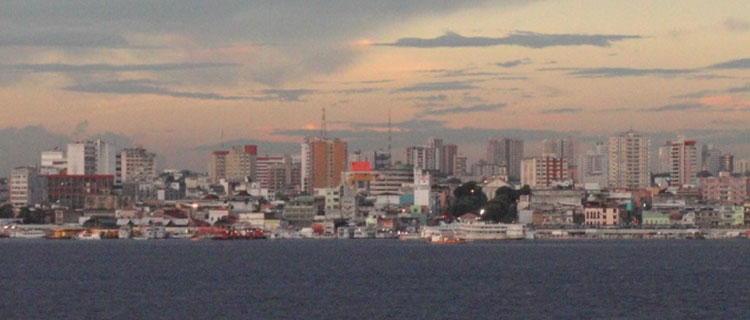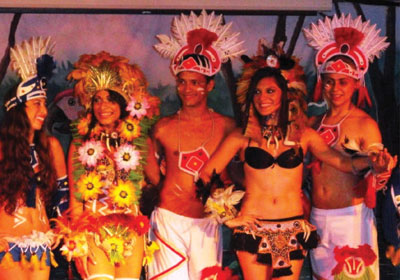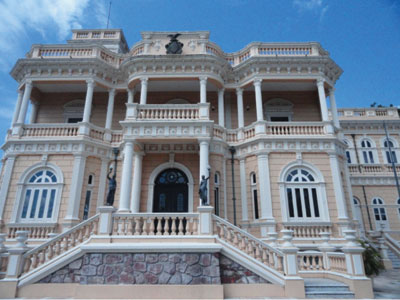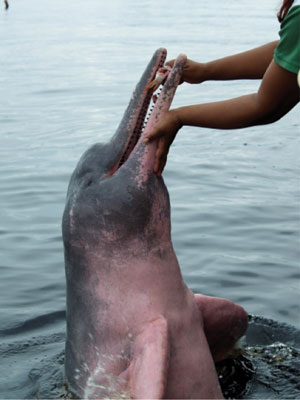Celebrating an anniversary with an Amazon adventure
This item appears on page 52 of the August 2013 issue.
by Karen Stensgaard; Philadelphia, PA
After many months of searching the globe for a unique spot in which to celebrate our 25th wedding anniversary, my husband, Michael, and I decided on the Amazon for our May 2012 trip. We sought a destination that we had never been to before and that would be pleasant in May.
Although we had been to Brazil several years before, we had not been to the country’s interior or the Amazon area. Because we didn’t want to rough it, we booked an Amazon River boat trip on the Iberostar Grand Amazon, which turned out to be an excellent choice.
Manaus
We flew to Manaus, the jumping-off point for the Amazon, via Panama City on Copa Airlines, affiliated with Continental Airlines. Manaus is a large city of more than two million inhabitants. Unfortunately, it does not have much in the way of activities for visitors.
Located in northern Brazil, the city is isolated, with a thousand miles of forest and jungle surrounding it and over 1,500 miles between it and the other major cities in Brazil, Rio de Janiero and São Paulo.
Before and after our river trip we stayed in Manaus, first at a Mercure Hotel and then at a Holiday Inn, two modern, high-rise hotels outside the downtown area. Both hotels were comfortable and offered large breakfast buffets, but they were not anything special, catering mainly to business travelers.
Interestingly, both were located very close to air-conditioned shopping malls — about the only place to go nearby.
Manaus has a tropical monsoon climate, but heavy rainfall is seasonal, with winter (summertime in the US) being less rainy; August, with less rain, is considered a dry month.
The average year-round temperature is about 80°F, but the high humidity makes it feel much hotter.
City sights
On our first day in Manaus, we wanted to get familiar with the city and visit the historic buildings and the port. While buses were plentiful, we didn’t find them easy to figure out and they did not travel the routes we needed.
Our hotel was located about a half hour’s walk from the downtown, according to the front desk. After reassuring the concerned hotel manager who gave us directions in English, we ventured out but ended up heading in the wrong direction. Battling the heat and humidity and dealing with a lack of sidewalks, we eventually gave up and found a cab to the opera house. From then on we relied on cabs to get to and from our intended destinations.
Teatro Amazonas, a beautiful opera house completed in 1896, is still used today. A friendly, knowledgeable, English-speaking guide gave us a personal tour, answering our many questions and showing us a room, not part of the main theater, with beautifully painted, mural-covered walls evoking the Amazon.
With many boats and much activity, the harbor was lively. A popular boat excursion visits the “Meeting of the Waters,” where the black Rio Negro meets the brown Solimões. For about four miles, both rivers run side by side without mixing because of the differing water temperatures and speeds of the currents. At 82°F, the Rio Negro flows approximately one mile per hour while the Solimões river is cooler and runs faster.
Around Manaus
The old market, Mercado Adolpho Lisboa, takes place in the same type of ornate metal structure as the now-defunct Les Halles market in Paris. However, while we were there, it was closed and under renovation, but we were still able to admire the original building.
Recent heavy rains and flooding had impacted Manaus. Some streets and another market by the water were flooded, but this didn’t seem to cause much concern among the locals. Cars and trucks drove through the waterlogged streets, and sandbags were placed on the sidewalks and streets so locals could walk around.
We twice attempted to tour the inside of the Centro Cultural Palácio Rio Negro, housed in the former home of a rubber baron, but both times it was closed. Unfortunately, even having our hotel call to confirm their hours didn’t seem to help, but the palace’s exterior and gardens were worth viewing.
About 11 miles from downtown Manaus is Ponta Negra beach, an upscale neighborhood with a beachfront and nightlife. An old, luxurious resort hotel, Tropical Manaus, is located at the west end of Ponta Negra. The hotel can be visited by the public, and we stopped to view the lobby and have a drink while cooling off in the shade in the vast pool area.
Cruising the Amazon
The Spanish hotel operator Iberostar has one ship, the Grand Amazon, an all-inclusive floating hotel that allowed us to cruise the Amazon in comfort with guides and smaller excursion boats.
Iberostar offers three itineraries on the Grand Amazon: four nights on the Rio Negro (our tour, for $1,644-$3,333 per person, double occupancy, or starting at $2,426 for a single), three nights on the Solimões ($1,245-$2,512 ppdo or from $1,831 single) and a combination of both for seven nights ($2,844-$5,800 ppdo or from $4,217 single).
We enjoyed each day and evening so much on our 4-night cruise that we both would have liked to have done the 7-night combination trip instead.
The ship, while probably not the typical modern American cruise ship, was well equipped, the staff was very helpful and attentive, and every day was a different adventure.
The ship holds up to 150 passengers, but there were only 30 on board for our trip. The number may have been low because of the flooding in the area and its not being a peak vacation time. We were happy it wasn’t full and glad it was smaller and more personalized, with easy access on and off for tours.
On the river
We were the only Americans on board; almost everyone else was Brazilian. The locals were friendly, and those who were able talked with us in English, as we don’t speak Portuguese.
The guides and staff on the ship all had a very good command of English, and we never felt left out of the updates while on tours. In fact, they often went above and beyond to make sure we understood what was going on.
We had excellent weather during the cruise, with only one day of heavy, torrential rain while sailing on the river. During the week we had intense, humid heat, so it wasn’t very pleasant to be out without being on the boat to catch a breeze.
The cruise itinerary included many excursions and events such as walking with a guide in the Jaraqui region of the Amazon jungle; cruising in smaller boats around the Anavilhanas islands, including a visit to an indigenous village; feeding pink dolphins at Novo Airão, and fishing for piranhas.
While there wasn’t much in the way of evening entertainment, the last night featured a local folklore show on the ship, and music in the bar and a dance floor were available nightly. We were also happy to just relax in our cabin or on our private balcony at the end of the day.
Wildlife
One evening, we went out looking for caimans (similar to alligators), the guide using a flashlight to find them. The light would momentarily blind the caiman so the guide could pick it up, holding it carefully. Apparently, the caiman is so shocked by the out-of-the-river experience that it remains relatively motionless for a bit. After we had a few minutes to see the caiman, it was placed back in the water.
This was the only after-dark boat trip we had, and it was an unusual but fascinating experience. The river looked and sounded different than it did during the daytime.
Another excursion featured pink dolphins, which swim freely in the river but know when visitors arrive with free food. At the pier, we were able to feed them and touch them briefly.
Monkeys were also visible from the boat, and one time they came on board for some bananas, carrying their young on their backs.
Many birds, including macaws, toucans and parrots, were seen in flight and in the trees along the riverbanks.
On the day we disembarked from the ship in the port of Manaus, we arranged with one of the guides to take a boat trip with four other passengers. We were in a small motorboat and cruised past houses outside the Manaus harbor area.
Many had been affected by the flooding and didn’t look inhabitable, but we were told that the flooding would recede in a few months. The locals gave us the impression that this was the norm.
We docked for lunch at a large, open-air restaurant and enjoyed a delicious buffet with lots of food, including fish from the river, for about $20 per person.
Overall, we had a great trip, but if we were planning it again, we’d spend less time in Manaus and more on the river.




